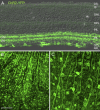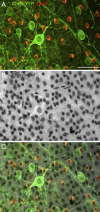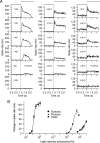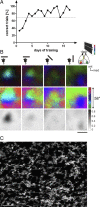Visual function in mice with photoreceptor degeneration and transgenic expression of channelrhodopsin 2 in ganglion cells
- PMID: 20592196
- PMCID: PMC6632886
- DOI: 10.1523/JNEUROSCI.4417-09.2010
Visual function in mice with photoreceptor degeneration and transgenic expression of channelrhodopsin 2 in ganglion cells
Abstract
The progression of rod and cone degeneration in retinally degenerate (rd) mice ultimately results in a complete loss of photoreceptors and blindness. The inner retinal neurons survive and several recent studies using genetically targeted, light activated channels have made these neurons intrinsically light sensitive. We crossbred a transgenic mouse line expressing channelrhodopsin2 (ChR2) under the control of the Thy1 promoter with the Pde6b(rd1) mouse, a model for retinal degeneration (rd1/rd1). Approximately 30-40% of the ganglion cells of the offspring expressed ChR2. Extracellular recordings from ChR2-expressing ganglion cells in degenerated retinas revealed their intrinsic light sensitivity which was approximately 7 log U less sensitive than the scotopic threshold and approximately 2 log U less sensitive than photopic responses of normal mice. All ChR2-expressing ganglion cells were excited at light ON. The visual performance of rd1/rd1 mice and ChR2 rd1/rd1 mice was compared. Behavioral tests showed that both mouse strains had a pupil light reflex and they were able to discriminate light fields from dark fields in the visual water task. Cortical activity maps were recorded with optical imaging. The ChR2rd1/rd1 mice did not show a better visual performance than rd1/rd1 mice. In both strains the residual vision was correlated with the density of cones surviving in the peripheral retina. The expression of ChR2 under the control of the Thy1 promoter in retinal ganglion cells does not rescue vision.
Figures











Comment in
-
Sensory systems: Back into the light.Nat Rev Neurosci. 2010 Aug;11(8):534. doi: 10.1038/nrn2893. Nat Rev Neurosci. 2010. PMID: 20672425 No abstract available.
Similar articles
-
Emergence of sustained spontaneous hyperactivity and temporary preservation of OFF responses in ganglion cells of the retinal degeneration (rd1) mouse.J Neurophysiol. 2008 Mar;99(3):1408-21. doi: 10.1152/jn.00144.2007. Epub 2008 Jan 23. J Neurophysiol. 2008. PMID: 18216234
-
Light-activated channels targeted to ON bipolar cells restore visual function in retinal degeneration.Nat Neurosci. 2008 Jun;11(6):667-75. doi: 10.1038/nn.2117. Epub 2008 Apr 27. Nat Neurosci. 2008. PMID: 18432197
-
Variable phenotypic expressivity in inbred retinal degeneration mouse lines: A comparative study of C3H/HeOu and FVB/N rd1 mice.Mol Vis. 2015 Jul 31;21:811-27. eCollection 2015. Mol Vis. 2015. PMID: 26283863 Free PMC article.
-
Optogenetic Strategies for Vision Restoration.Adv Exp Med Biol. 2021;1293:545-555. doi: 10.1007/978-981-15-8763-4_38. Adv Exp Med Biol. 2021. PMID: 33398841 Review.
-
Channelrhodopsins: visual regeneration and neural activation by a light switch.N Biotechnol. 2013 Jun 25;30(5):461-74. doi: 10.1016/j.nbt.2013.04.007. Epub 2013 May 7. N Biotechnol. 2013. PMID: 23664865 Free PMC article. Review.
Cited by
-
Photochemical restoration of visual responses in blind mice.Neuron. 2012 Jul 26;75(2):271-82. doi: 10.1016/j.neuron.2012.05.022. Neuron. 2012. PMID: 22841312 Free PMC article.
-
Degenerated Cones in Cultured Human Retinas Can Successfully Be Optogenetically Reactivated.Int J Mol Sci. 2020 Jan 14;21(2):522. doi: 10.3390/ijms21020522. Int J Mol Sci. 2020. PMID: 31947650 Free PMC article.
-
An Ultra-Sensitive Step-Function Opsin for Minimally Invasive Optogenetic Stimulation in Mice and Macaques.Neuron. 2020 Jul 8;107(1):38-51.e8. doi: 10.1016/j.neuron.2020.03.032. Epub 2020 Apr 29. Neuron. 2020. PMID: 32353253 Free PMC article.
-
Optogenetic approaches to retinal prosthesis.Vis Neurosci. 2014 Sep;31(4-5):345-54. doi: 10.1017/S0952523814000212. Epub 2014 Aug 6. Vis Neurosci. 2014. PMID: 25100257 Free PMC article. Review.
-
Present Molecular Limitations of ON-Bipolar Cell Targeted Gene Therapy.Front Neurosci. 2017 Mar 29;11:161. doi: 10.3389/fnins.2017.00161. eCollection 2017. Front Neurosci. 2017. PMID: 28424574 Free PMC article.
References
-
- Berndt A, Yizhar O, Gunaydin LA, Hegemann P, Deisseroth K. Bi-stable neural state switches. Nat Neurosci. 2009;12:229–234. - PubMed
-
- Berson DM. Strange vision: ganglion cells as circadian photoreceptors. Trends Neurosci. 2003;26:314–320. - PubMed
-
- Berson DM, Dunn FA, Takao M. Phototransduction by retinal ganglion cells that set the circadian clock. Science. 2002;295:1070–1073. - PubMed
MeSH terms
Substances
LinkOut - more resources
Full Text Sources
Other Literature Sources
Molecular Biology Databases
Research Materials
Miscellaneous
